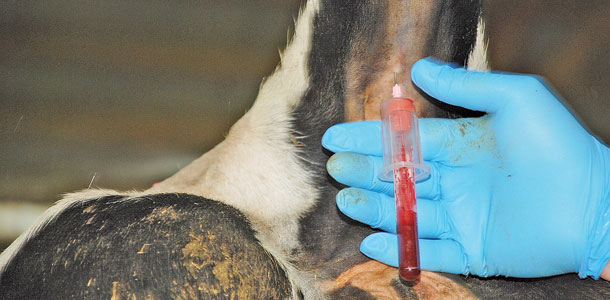There are many tools available in the toolbox of livestock managers that can be used to maximize reproductive efficiencies. One of these tools is blood-based pregnancy tests. Over the last 10 years, this technology has been gaining in popularity as a tool to find the open cow.
Using this tool, the pregnancy status of an animal can be determined as early as 28 days post-breeding with a high degree of accuracy. How accurate is dependent on the test, but many of these tests are more than 99 percent accurate at identifying an animal as open.
The parameter of use varies for each test, but generally, these tests can be used as early as 28 days post-breeding and 60 to 90 days postpartum.
The identification of open cows and heifers accurately and early post-breeding is a vital component of any reproductive management program on a dairy. This allows for an increase in herd reproductive efficiencies by shortening the interbreeding interval, leading to a decrease in days open and an increase in the percentage of the herd bred early in lactation.
The interbreeding interval can be further decreased by combining estrus synchronization and timed A.I. protocols with the detection of open animals early post-breeding. The shorter interbreeding interval provides more opportunities for a cow to become pregnant after the voluntary waiting period has passed.
Develop and implement a resynchronization protocol
The benefits of an early “open” check and a shortened interbreeding interval will never be realized unless a resynchronization protocol has been identified and implemented. There are many variables that need to be analyzed when determining which protocol a dairy would use and when the protocol needs to be implemented.
In order to decrease the interbreeding interval, the intervention needs to occur as early as possible without sacrificing efficiencies and reproductive rates. Research conducted at the University of Wisconsin has shown when the pregnancy diagnosis and subsequent resynchronization was initiated on days 26 and 33, higher pregnancy rates per A.I. were observed than when initiated earlier post-breeding.
The research further indicated that resynchronization initiated on day 33 yielded the highest pregnancy rate per A.I. Part of the reason for this is the effects of early embryonic death, which we will discuss later in this article.

Today, there are many protocols that can be used for resynchronization in cattle, and each of them have had a great deal of research performed. The Dairy Cattle Reproductive Council and other organizations have great resources that can be used to determine the resynchronization protocol that will best suit your operation.
During the 2009 AABP annual conference, Dr. Bob Vlietstra from West Michigan Veterinary Service gave the following advice to his fellow veterinarians about protocol development. “Protocol development is dependent on days in milk (DIM) and number of available open cows.”
He then went on to state, “If the farm needs to be concerned about open days and it has a large number of eligible cows, a protocol that minimizes days to a service but has a decreased conception rate may give them enough numbers of pregnancies per cohort.
However, if a farm has relatively low days open and a minimal number of cows to be bred, a protocol which maximizes conception rate is preferable.” In addition to the selection of a protocol, it is necessary to be continually monitoring to determine its success. He further recommends that the data collected be stored and evaluated weekly.
Account for early embryonic death
It is imperative that early embryonic death be accounted for when developing management protocols. The amount of loss observed is highly dependent on the herd, the season and other variables.
A study in 1997 used ultrasound to analyze pregnancy loss at various stages of gestation. They found the following rates of pregnancy losses during early pregnancy: 11 percent from 28 to 42 days, 6 percent from 42 to 56 days, and 2 percent from 56 to 98 days post-A.I.
This and other studies indicate that the greatest proportion of embryo loss occurs between an early pregnancy check (28 days post-breeding) and day 45 post-breeding.
Keeping this in mind when determining the timing of confirmation checks, they need to also occur as soon as possible but not too early that further losses are incurred because of embryonic loss. Many suggest that the confirmation of pregnancy occur between 45 and 60 days post-breeding after the majority of the early embryonic death has occurred.
This allows for the early detection of anything that might have been pregnant at the time of the initial pregnancy check but has resulted in early embryonic death loss. Cows identified as open are found early and enrolled in the herd’s resynchronization protocol.
Blood-based pregnancy tests are a tool that can be used by the dairy management team to provide necessary reproductive status information in order to maximize the reproductive efficiencies of the herd. PD
References omitted due to space but are available upon request. Click here to email an editor.
Jeremy Howard was formerly with BioTracking LLC. For more information about blood-based pregnancy tests, contact BioTracking LLC by email.
PHOTOS:Blood-based pregnancy tests are a tool that can be used by the dairy management team to provide necessary reproductive status information in order to maximize the reproductive efficiencies of the herd. Photos courtesy of BioTracking.






